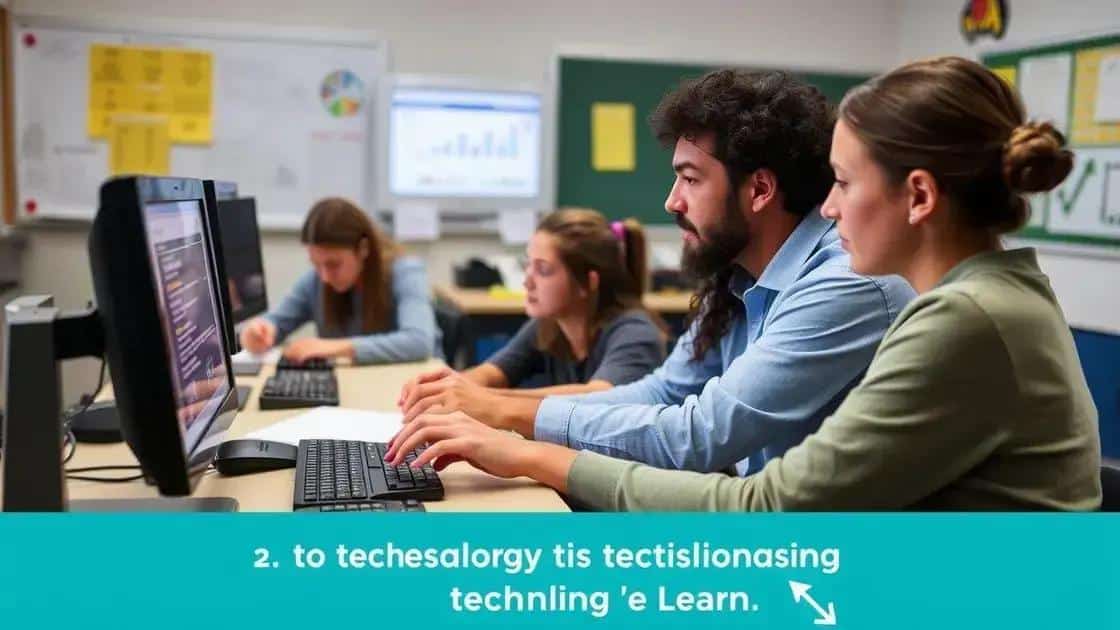Insights on school technology integration for better learning

Integrating technology in education enhances student engagement and achievement by providing interactive tools, resources, and personalized learning experiences that directly impact academic performance.
Insights on school technology integration can truly transform how students engage with learning. Have you ever wondered what tools teachers are using to make lessons more interactive? This article dives into effective strategies and practices.
Understanding the role of technology in schools
Understanding the role of technology in schools is crucial for both students and educators. It shapes how lessons are taught and how students learn. By integrating technology, schools can offer more engaging and personalized learning experiences.
The Transformation of Learning
Technology is not just a tool; it is a transformation agent. It allows students to explore information beyond the classroom walls. Interactive tools can lead to deeper understanding and retention of knowledge.
Benefits of Technology in Education
Here are some key benefits:
- Enhanced Engagement: Interactive lessons captivate students’ attention.
- Access to Resources: Students can access a wealth of information online.
- Collaboration Opportunities: Students collaborate better using digital platforms.
- Customization: Learning can be tailored to each student’s needs.
This integration can also introduce challenges. Teachers must be trained in using technology effectively. Moreover, there can be issues regarding infrastructure and access to devices. Despite these challenges, the positive impact of technology on education is hard to ignore.
Furthermore, the role of educators evolves with technology. They become facilitators rather than just information providers. Technology enables them to provide personalized support. This ensures that each student can thrive in a digital learning environment.
As schools continue to incorporate technology, it’s vital to evaluate and adapt methods. Understanding these changes helps in creating a robust educational framework that benefits everyone involved. The integration of technology in education is an ongoing journey, but one that promises to yield abundant rewards.
Key benefits of integrating technology in education

Integrating technology in education offers numerous advantages that can enhance the learning experience for students. By utilizing modern tools, teachers can create more interactive and engaging environments.
Improved Student Engagement
One key benefit of technology is improved student engagement. When students use devices like tablets and laptops, they are often more focused and interested in their lessons. Interactive content, such as videos and games, can make learning more enjoyable.
Access to Information
Technology provides students with instant access to a vast array of information. They can research topics thoroughly and gain insights from multiple sources. This encourages independent learning, which is essential in today’s world.
- Immediate Feedback: Technology helps students receive quick feedback on assignments and tests.
- Variety of Learning Styles: Different resources cater to various learning preferences, ensuring everyone can succeed.
- Collaboration Opportunities: Students can work together on projects from different locations, fostering teamwork.
- Flexible Learning: Learning can occur anytime and anywhere, which helps accommodate different schedules.
Moreover, teachers benefit from technology as it allows for more efficient lesson planning and assessment. Educators can track student progress using software and apps, making it easier to identify areas that need improvement.
As schools invest in technology, they can provide training for teachers, which helps them utilize these tools effectively. By embracing technology in education, teachers can prepare students for a digital future. The skills learned today will be invaluable in tomorrow’s workplace.
Ultimately, integrating technology in education is not just about having the latest gadgets; it’s about creating a learning environment that supports growth and sparks curiosity. With the right tools, both students and teachers can thrive.
Strategies for successful technology implementation
To ensure successful technology implementation in schools, it is essential to follow effective strategies. These strategies help integrate various tools and resources smoothly, enhancing learning experiences for both students and educators.
Assessing Needs and Goals
The first step is assessing the specific needs of the school and setting clear goals. Understanding what technologies best fit the curriculum is vital. Engaging with teachers to gather input can provide valuable insights. This ensures that the tools chosen will enhance the learning environment.
Training Teachers
Another key strategy is providing training for educators. It is not enough to have technology; teachers need to know how to use it successfully in their lessons. Workshops and ongoing support can help teachers become more comfortable with new tools.
- Ongoing Professional Development: Regular training allows teachers to stay updated on new technologies.
- Peer Collaboration: Encouraging teachers to share their experiences can foster a supportive learning community.
- Hands-On Practice: Allowing teachers to explore technology before using it in class builds confidence.
Additionally, implementation should be gradual. Instead of trying to integrate multiple technologies at once, schools can start with one or two. This allows for proper feedback and adjustments along the way. As teachers and students become more familiar with the initial tools, more technologies can be added.
Continuous evaluation is critical. Schools should regularly assess the effectiveness of the technology in meeting educational goals. This can involve surveying teachers and students about their experiences. Based on feedback, adjustments can be made to improve usage and effectiveness.
Involving parents and the broader community can also support successful implementation. Sharing updates about technology initiatives can help garner support and enthusiasm. This can create a more collaborative environment where everyone feels invested in the success of technology integration.
Measuring the impact of technology on student outcomes

Measuring the impact of technology on student outcomes is essential for understanding its effectiveness in education. Schools need to evaluate how technology changes learning experiences and improves academic performance.
Data Collection Methods
To measure this impact, schools can use various data collection methods. Surveys are a valuable tool for gathering feedback from students and teachers about their experiences with technology. These surveys can help identify areas of improvement.
Standardized Test Scores
Another way to assess the effectiveness is by examining standardized test scores. Comparing scores before and after implementing technology can showcase trends in academic performance. However, it’s important to consider other factors that may influence these scores.
- Observation: Teachers can observe changes in student engagement and participation during lessons involving technology.
- Assignment Performance: Monitoring how students perform on assignments can also indicate the impact of technology.
- Classroom Participation: Increased participation in discussions may suggest that students feel more comfortable using technology.
In addition, analyzing attendance records and dropout rates can provide insights into how technology affects student retention. Schools can see if students are more motivated to attend classes when technology is integrated into learning.
Another important aspect is qualitative feedback. Gathering stories or testimonials from students and teachers can highlight the personal impact of technology. These narratives can reveal how technology helps foster a love for learning or builds confidence.
Ultimately, schools should adopt a balanced approach by using both quantitative and qualitative measures. This holistic view provides a better understanding of the impact of technology on education, helping to inform further decision-making.
In summary, technology plays a vital role in enhancing education. By integrating technology in effective ways, schools can improve student engagement and achievement. It is important to measure the impact of these tools to ensure they meet the needs of students and educators alike. Continuous evaluation and feedback will help in making informed decisions and refining approaches. With thoughtful implementation, technology can significantly transform learning environments, preparing students for a digital future.
FAQ – Frequently Asked Questions about Technology in Education
How does technology improve student engagement?
Technology uses interactive tools and resources that make learning more enjoyable, keeping students focused and interested.
What methods are used to measure the impact of technology in schools?
Schools often use surveys, test scores, and observation to assess how technology affects student learning and engagement.
Why is teacher training important for technology implementation?
Training helps teachers become comfortable with new tools, enabling them to effectively integrate technology into their lessons and support student learning.
How can parents support technology use in schools?
Parents can engage by providing feedback, attending meetings about technology initiatives, and encouraging their children to explore learning tools.






